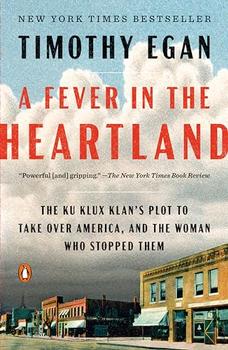Summary | Excerpt | Reading Guide | Discuss | Reviews | Beyond the book | Read-Alikes | Genres & Themes | Author Bio

The Ku Klux Klan's Plot to Take Over America, and the Woman Who Stopped Them
by Timothy EganA historical thriller by the Pulitzer and National Book Award-winning author that tells the riveting story of the Klan's rise to power in the 1920s, the cunning con man who drove that rise, and the woman who stopped them.
The Roaring Twenties—the Jazz Age—has been characterized as a time of Gatsby frivolity. But it was also the height of the uniquely American hate group, the Ku Klux Klan. Their domain was not the old Confederacy, but the Heartland and the West. They hated Blacks, Jews, Catholics and immigrants in equal measure, and took radical steps to keep these people from the American promise. And the man who set in motion their takeover of great swaths of America was a charismatic charlatan named D.C. Stephenson.
Stephenson was a magnetic presence whose life story changed with every telling. Within two years of his arrival in Indiana, he'd become the Grand Dragon of the state and the architect of the strategy that brought the group out of the shadows – their message endorsed from the pulpits of local churches, spread at family picnics and town celebrations. Judges, prosecutors, ministers, governors and senators across the country all proudly proclaimed their membership. But at the peak of his influence, it was a seemingly powerless woman – Madge Oberholtzer – who would reveal his secret cruelties, and whose deathbed testimony finally brought the Klan to their knees.
A Fever In the Heartland marries a propulsive drama to a powerful and page-turning reckoning with one of the darkest threads in American history.
Egan's research of this nearly 100-year-old story is detailed and he makes the case that the details were imperative to the results. Oberholtzer's death triggered the death of the Klan. The Klan strategy of bribing and influencing rural men triggered boundless fantasies. One of the more ridiculous ones was that the Klan had the political capital, chops and numbers to win the White House and rule the United States...continued
Full Review
 (795 words)
(795 words)
(Reviewed by Valerie Morales).
Timothy Egan's book A Fever in the Heartland mentions the Women of the Ku Klux Klan, a group of women who were actively aligned with the mission of the KKK during its 1920s resurgence. In 1923, the WKKK formed in Little Rock, Arkansas. The WKKK had chapters in every state and at least 500,000 members over the course of its existence. There were certain requirements for membership: white, native-born, Protestant. Members believed in the separation of church and state, and that women shouldn't be relegated to only being housewives and mothers.
They also, like their male counterparts, were against racial mixing and thought it was a similar crime to treason. Intermingling, as they put it, was defying the laws of God and man. The Klanswomen'...

If you liked A Fever in the Heartland, try these:

by Kellie Carter Jackson
Published 2025
A radical reframing of the past and present of Black resistance—both nonviolent and violent—to white supremacy.

by Mark Whitaker
Published 2025
Published to coincide with the hundredth anniversary of his birth, the first major study of Malcolm X's influence in the sixty years since his assassination, exploring his enduring impact on culture, politics, and civil rights.
Give me the luxuries of life and I will willingly do without the necessities.
Click Here to find out who said this, as well as discovering other famous literary quotes!